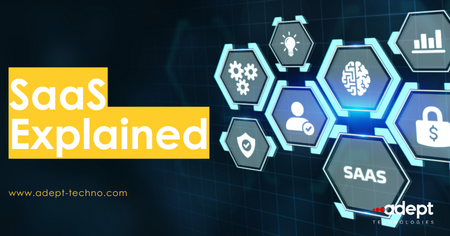Understanding SaaS
Software as a service (or SaaS) is a way of delivering applications over the Internet—as a service. Instead of installing and maintaining software, you simply access it via the Internet, freeing yourself from complex software and hardware management.
With a SaaS platform, you subscribe to a service that hosts the software via the cloud and cloud computing. You can also easily update or upgrade the platform with the latest features as well as access it no matters where you are.
The cloud-based model is so common now that more than 60% of software seekers who call Software Advice only want web-based products—less than 2% specifically ask for on-premise software.
The traditional on-premise software delivery model differs from SaaS in two key ways:
- SaaS deployments don’t require extensive hardware, which allows buyers to outsource most of the IT responsibilities typically required to troubleshoot and maintain the software in-house.
- SaaS systems are typically paid within a subscription model, whereas on-premise software is usually purchased through a perpetual license, paid upfront.
Example of SaaS in practice
Hubspot
HubSpot is actually one of the few companies called “fully integrated”, as they have products in every stage of the SaaS business model! From their Content Management System (CMS), Social Media Marketing Platform, and Email Marketing Tools to their Analytics Suite – this company’s got you covered.
If you’re looking for an all-inclusive platform that can help you manage your business in one location, HubSpot is an excellent choice.
Dropbox

Dropbox is a leading cloud storage SaaS company that makes it easier for businesses to store, share, and collaborate on files and data on the go. It offers you a smart workplace that lets your workforce work from anywhere. Dropbox is a perfect SaaS company for businesses that rely heavily on freelancers and remote workforce. The smart content suggestion is a great feature that recommends content based on your Dropbox activity. Paper by Dropbox is a document for teams where team members collaborate without any hurdles.
Amazon Web Services

Nothing beats Amazon Web Services (AWS) as a SaaS example. With more than 150 services on offer, AWS provides businesses and individuals with all the tools they need such as databases, IoT, business applications, machine learning, storage, robotics, security, customer engagement, blockchain, and more. All the apps are cloud-based which means you can use these tools from any internet-enabled device.
Is SaaS customizable?
Yes! Today’s web-based software is adaptable enough to be customized not only for specific business purposes but also for individual users. Buyers can change the look and feel of the program by customizing the user interface (UI), as well as changing specific areas, such as data fields, to change what data appears. A number of business process features can also be toggled on and off at will. Modern SaaS applications offer personalization and configuration within the application and are always ready for upgrades and enhancements without the need for technical assistance.
Users can frequently customize their own personal workspace, such as a dashboard or task list, to display only the information they need to see and optimize their individual work styles.
How secure is Saas?
Clients are wary of cloud security, so software providers work hard to demonstrate how to secure data on their servers. Many SaaS providers deploy and store their software instances and data in highly secure public cloud services. For most businesses, data is more vulnerable in-house, where there is less budget dedicated to IT security and employees or others may unintentionally leak data or introduce security gaps. According to Gartner, through 2023, at least 99% of cloud security failures will be the user’s fault.
The benefits of SaaS
Many businesses turn to cloud-based SaaS solutions for increased efficiency and cost-effectiveness. Among the benefits are:
- Low infrastructure and setup costs
You simply pay for what you require, with no capital outlay that must be depreciated on your balance sheet over time.
- Accessible from any location
Simply connect to the internet and you can work from anywhere using a desktop, laptop, tablet, mobile, or another networked device. - Scalability
As your business grows, you can adjust your requirements based on the number of people who need to use the system, the volume of data, and the functionality required. - Regular, automatic updates
Because of their scale and feedback on what their customers require, providers provide timely improvements. This frees up your IT department for more critical business tasks.
The future of SaaS
High-performance computing will be useful in the future for a variety of business applications, such as analyzing large amounts of customer data and monitoring application logs. SaaS may one day be able to assist businesses in addressing critical challenges such as predicting which customers will churn or which cross-selling practices work best for your company.
With the increasing need for high-volume data, software performance, and backup, it’s easy to see why so many businesses are turning to cloud-based providers. If you’re thinking about switching to a SaaS platform, check out what we have to offer for businesses of all sizes.
Ready for the cloud? Here’s how to get started
You can contact us for a free shortlist of possible solutions and services. You can also arrange a free phone consultation or virtual meeting at a time that is convenient for you.
[vc_row][vc_column][vc_wp_posts number=”5″][/vc_column][/vc_row]


